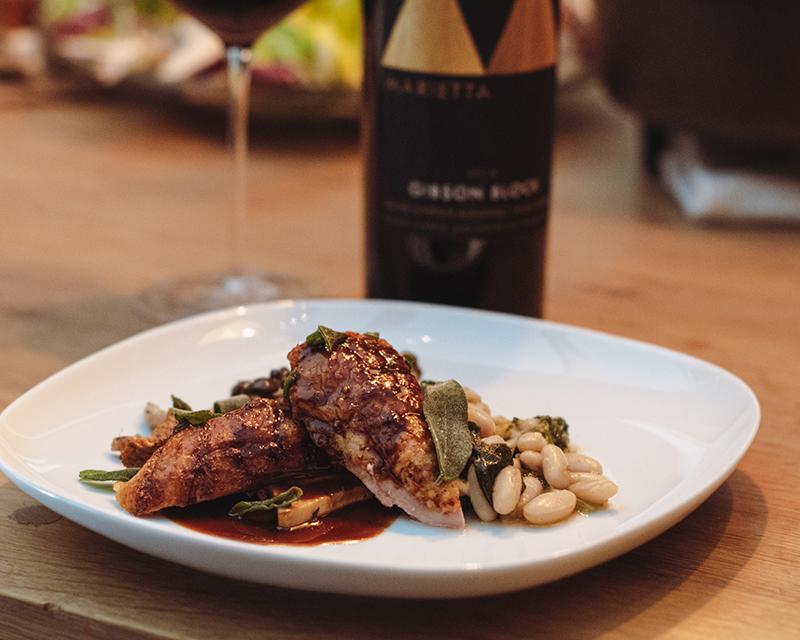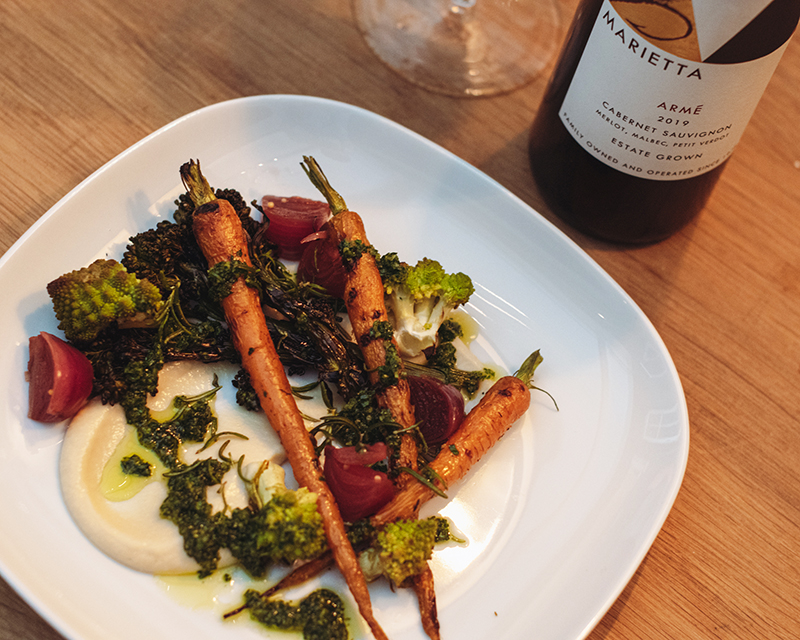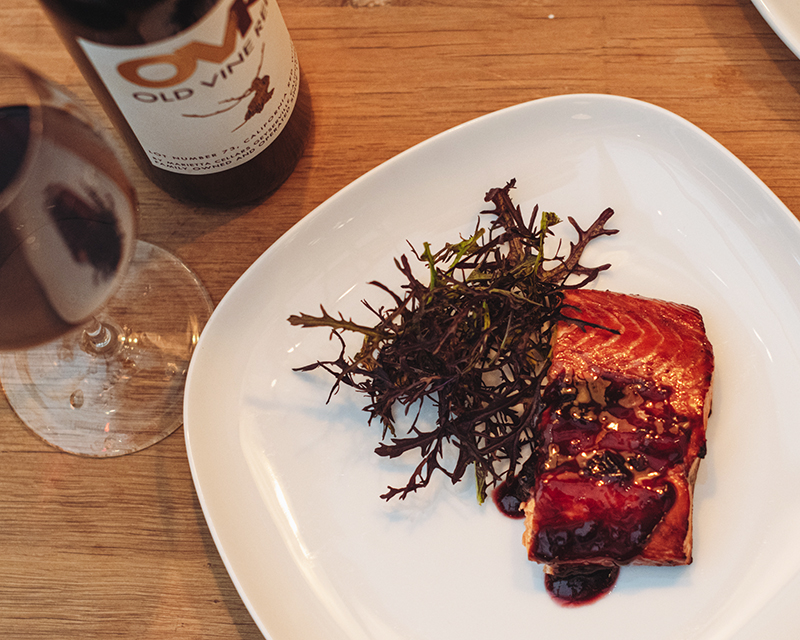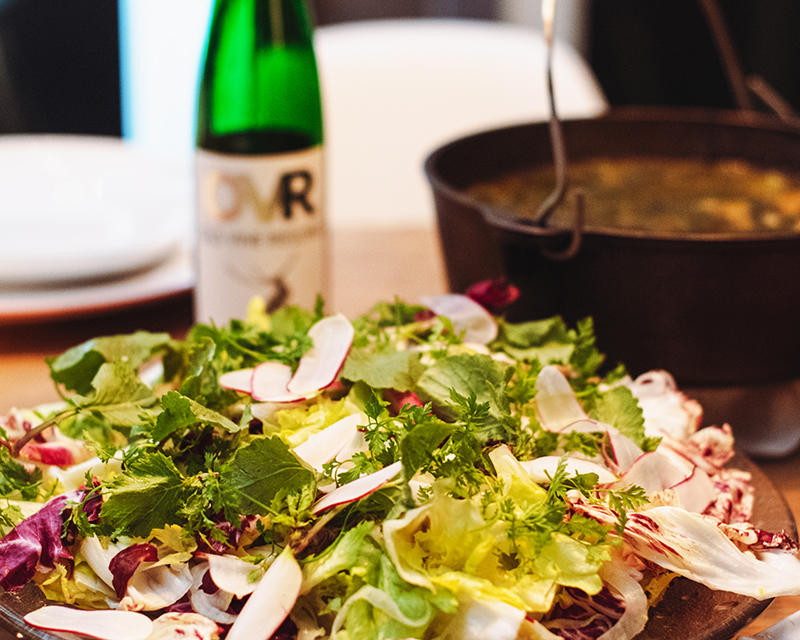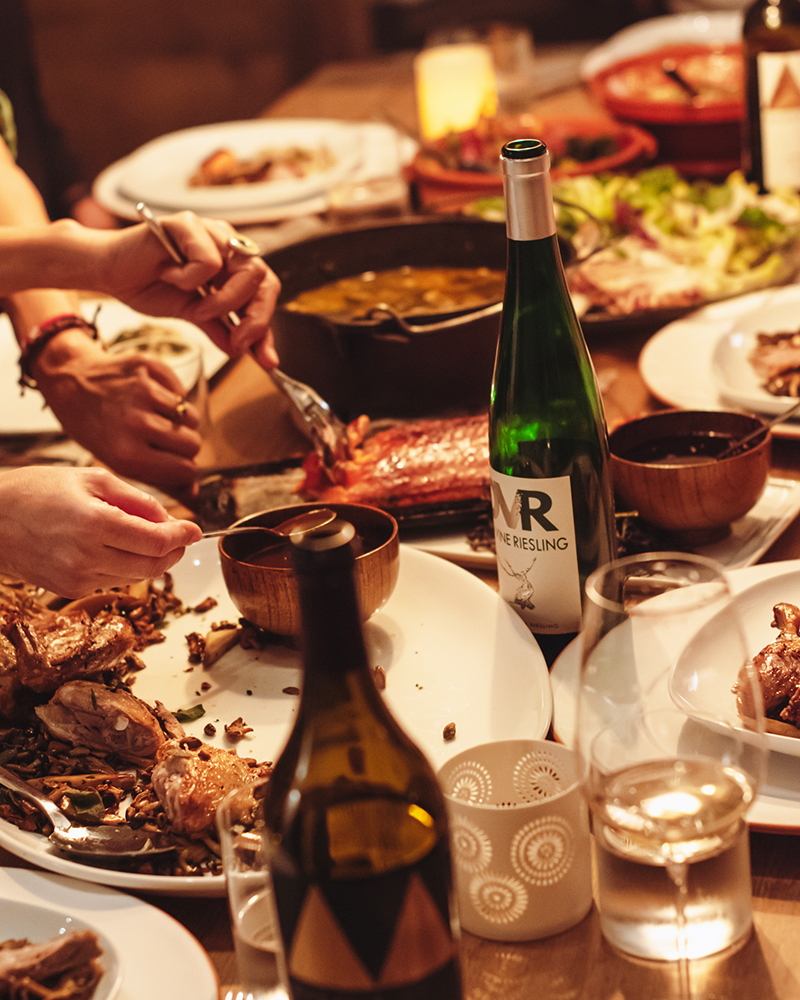2022 Winter Menu and Wine Pairings
Gather around, friends; our winter menu is sure to warm both heart and home. Read on for inspiration from our table to yours.
OUR 2022 WINTER MENU AND WINE PAIRINGS
Roasted Duck with Wild Mushrooms, White Beans, and Escarole
Gibson Block Syrah
~
Grilled Winter Vegetables with Smoked Cauliflower Purée and Pickled Cipollini Onions
Armé Cabernet Sauvignon
~
Cedar-Smoked Steelhead
Old Vine Red
~
Chicory Salad with French Breakfast Radishes and Meyer Lemon Vinaigrette
Old Vine Riesling
The Gibson Block is the heart of the McDowell Valley AVA and is planted with some of the oldest known Syrah and Grenache in California. This ancient, dry-farmed mixed block next to the original homestead has been producing grapes for nearly 150 years. As a result of the vine age and minuscule yield, Gibson Block Syrah is dark and intense, a heady mix of mulberry and lavender that dominates the nose, with an edge of cinnamon stick. Broad, mouth-coating tannins are tethered to a core of smooth, sleek, powerful texture that’s balanced by vibrant acidity. Delicious now yet built to age, pair with hearty fare such as cured meats and ripe cheeses, or duck with sage and cherries.
Roasted Duck with Wild Mushrooms, White Beans, and Escarole: A whole duck is seasoned generously with salt and coarse-ground black pepper and roasted until golden brown. To accompany this showstopper, Cannellini beans are soaked overnight then simmered in salted water until tender. Blanched escarole greens are stirred in with sizzled garlic at the end of cooking. To complete the dish, wild mushrooms are sauteed and finished with sizzled garlic and thyme. A sauce made from reduced duck or chicken stock, roasted bones, browned carrots, celery, and onion, and a few cups of Gibson Block Syrah brings the whole meal together.
INGREDIENTS
1 whole duck
1/2 bunch sage
1 cup dried Cannellini beans
1/2 head escarole; trimmed and washed
2 cloves garlic; chopped
Crushed red pepper
1 sprig rosemary; chopped
1 lb preferred mushrooms
1/2 bunch thyme
1 large carrot; peeled and cut into 1/2” cubes
1 yellow onion; peeled and cut into 1/2” cubes
1 rib celery; cut into 1/2” slices
1 qt concentrated chicken or duck stock
2 cups Gibson Block Syrah
Salt
Black pepper
Olive oil
Roasted Duck: Remove neck and giblets from duck. Discard giblets, reserve bones for the sauce. Pat dry then score skin/fat of breasts to help render the fat during cooking. Season generously with salt and coarse ground black pepper. Leave uncovered in refrigerator overnight to dry skin. Roast duck in cast iron pan or on a baking sheet with a rack at 425° for 15 minutes, then drop to 375° until golden brown, occasionally brushing with drippings. A thermometer inserted into the thickest part of the thigh should read 145°.
White Beans and Escarole: Soak dried Cannellini beans in cold water overnight. Drain and add to medium pot with enough water to cover by at least one inch. Season generously with salt and a few pours of olive oil then bring to a simmer. Cook until beans are fully tender, but not falling apart. Separately, bring a pot of salted water to a boil. Add escarole and cook until tender. Strain greens then add to beans. Sizzle garlic, rosemary, and hot pepper in a little bit of olive oil then add to beans and escarole. Stir together.
Wild Mushrooms: Trim and clean mushrooms. Cut into halves or quarters then add to parchment-lined baking sheet with a little olive oil and salt. Roast in 375° oven until tender and browned. Sizzle picked thyme and one clove of chopped garlic in olive oil then toss with mushrooms.
Sauce: Sear reserved duck bones until deeply browned. Remove from pan and add carrots, celery, onion and cook until browned and fragrant. In a medium pot, reduce 2 cups of Gibson Block Syrah by half then add stock, browned bones, and vegetables. Simmer gently until the sauce coats the back of a wooden spoon. Strain and season with salt.
Fried Sage: Pick sage leaves and fry in a small amount of 325° oil for a few seconds. Remove to a tray lined with paper towels or cloth.
To serve: Carve duck into servings. Place a few spoonfuls of beans and escarole on plate with mushrooms tucked into the side. Lay duck over top and add sauce just below. Sprinkle sage over the dish. Pair with Gibson Block Syrah.
A dazzling balance between modern California and Old World style, this wine is rich and dense with layers of black currant and dark cherry counterbalanced by sandalwood and Kalamata, finishing with lasting hints of mint and briar. The opulent mouthfeel is full and textural yet remarkably silky thanks to the optimal phenolic ripeness of the fruit. Armé Cabernet Sauvignon pairs beautifully with herbed roasts, asparagus, garlicky beans, and all manner of savory meats and veggies.
Grilled Winter Vegetables with Smoked Cauliflower Purée, Pickled Cipollini Onions, and Gremolata: Baby carrots, Romanesco, and broccolini are grilled and served with cauliflower that has been smoked over hickory, cooked in cream and garlic, then puréed. Cipollini onions are pickled in red wine vinegar, mustard seeds, thyme, and bay laurel, bringing a brightness that balances the full-bodied purée and Maillard reaction on the vegetables. Finish with chopped parsley, lemon peel, garlic, and a drizzle of your favorite California olive oil to tie the whole dish together.
INGREDIENTS
1 head white cauliflower
2 cups heavy cream
2 1/4 cups water
3 cloves garlic
1 sprig thyme
1 bunch small/medium carrots
1 bunch broccolini
1 head romanesco
5 cipollini onions
1 cup red wine vinegar
1 tbsp mustard seed
Sugar; to taste
1 bay leaves
1/2 bunch parsley
1 eureka lemon
Olive oil
Salt
Fine-cut hickory chips
Aluminum foil
Smoked Cauliflower Purée: Discard leaves and stem end from cauliflower. Cut the head into small pieces and set aside. Use a heavy-bottomed pot with a perforated insert and tight-fitting lid to create a stovetop smoker. Using aluminum foil, create a palm-sized pouch and fill it with about a quarter cup of hickory chips. Place pouch into the bottom of the pot and heat on the stove until it begins to smoke. Reduce heat to medium-low then add cauliflower to perforated insert, set into pot above wood chips, and cover tightly for 10-15 minutes or until wood chips appear burned out.
In a medium pot, heat cream with thyme, garlic, 2 cups water, and a few pinches of salt. When cauliflower is smoke-tinted, add to cream mixture and simmer until fully-tender, then purée smoothly in blender. If too thin, reduce in pot on stove over low heat until desired consistency.
Pickled Cipollini Onions: Heat vinegar and 1/4 cup water with bay leaf, then season to taste with salt and sugar. Separately, bring cold water and mustard seeds to a boil 3 times, changing the water between boils to remove tannins from seeds. Peel and cut cippolini’s into quarters or sixths depending on size. Simmer in pickling liquid until just tender. Remove from heat, add mustard seeds and pour into a mason jar to cool.
Grilled Vegetables: Peel carrots, cut romanesco into florets, trim ends of broccolini, then toss all in olive oil and salt. Grill over medium heat until tender.
Gremolata: Peel lemon and remove any white pith. Chop lemon peel finely along with parsley leaves and one clove of garlic. Set aside
To serve: Add a smear of cauliflower to the plate, layer grilled vegetables atop, then scatter pickled cippolini’s. Finish by sprinkling the gremolata over the grilled vegetables, and add a drizzle of olive oil around the plate. Pair with Armé Cabernet Sauvignon.
OVR is bright and juicy, with strawberry and black raspberry supported by savory notes of briar and slate. Barrel-aged Syrah and Petite Sirah give fruity and fresh Zinfandel added complexity and length, while a touch of Grenache and Barbera lends complex red fruit character and a hint of red licorice and white pepper. Pair Old Vine Red with a wide range of foods from pizza, pasta, burgers, and roasted veggies, to tacos, steelhead, and salmon.
Cedar-Smoked Steelhead: Steelhead trout is laid skin side down on a length of charred cedar plank and placed onto the grill over low heat until firm. Occasionally brushing the fish with a blend of Old Vine Red and puréed sour cherries creates a beautiful glaze that will hold onto those smoky cedar flavors. For the glaze, puréed sour cherries, OVR, bay laurel, and black peppercorn are reduced—the remaining portion cascaded over the finished trout for a vibrant complementing sauce. A small handful of bitter greens such as mustard frills adds a peppery finish to the dish and leaves no shortage of elegance.
INGREDIENTS
1 cedar plank; soaked in water for at least one hour
1 side steelhead trout; skin on; pin bones removed
1/2 cup tart cherry purée
1 cup Old Vine Red
2 bay leaves
5 black peppercorns
1 sprig thyme
A few handfuls of mustard frills or arugula; washed
Salt
Cedar-Smoked Steelhead: Season trout with salt and let it come up to just under room temperature. Heat 1 cup Old Vine Red and cherry purée with bay leaves, thyme, and peppercorn.
Turn grill to high and char one side of cedar plank. Flip cedar plank over and gently lay steelhead skin side down over charred board. Return to grill and drop the heat to low. Brush with wine and cherry mixture occasionally. Cook until firm.
Reduce the remaining mixture by a quarter and season with salt then strain.
To serve: Slice fish into portions and remove to plate leaving the skin behind on cedar plank. Spoon sauce over plated fish and add a small amount of bitter greens next to the fish. Pair with Old Vine Red.
This wine balances tropical, citrus, and jasmine aromas, all intermingled with the minerality of an ocean breeze. With a rich, textured, waxy mouthfeel, its long finish is a perfect counterpoint to the tart, lip-smacking acidity. Bone dry, it’s an excellent foil for food, particularly anything with a shell. Pair Old Vine Riesling with steamed shellfish or raw bar fare, match it with citrus-based salads, or serve it as a counterbalance to rich sauces.
Chicory Salad with French Breakfast Radishes and Meyer Lemon Vinaigrette: An abundant mix of winter chicories is dressed in a vinaigrette made from tart and sweet Meyer lemons, Dijon, garlic, and bright olive oil, then garnished with crisp French Breakfast radishes and their tops.
INGREDIENTS
1 head each escarole, radicchio, castlefranco, and frisée
1 bunch French breakfast radishes
2 Meyer lemons
1 tsp Dijon mustard
1 clove garlic; pounded with mortar and pestle
1/2 cup olive oil
Salt
Lettuces: Remove outer layers of chicories and trim green tops from escarole and frisée leaving behind the sweeter yellow/white centers. Discard tops/outers or save for later cooking. Trim the root to separate the leaves then wash in cold water and dry in strainer or salad spinner.
Meyer Lemon Vinaigrette: Cut one lemon into quarters, remove any seeds, then slice as thinly as possible. Turn perpendicular and cut slices into tiny bits. Mix lemon bits with garlic, Dijon, and the juice from the second lemon. Let sit for 15 minutes to soften, then add olive oil and salt to taste.
Radishes: Clean radishes and trim away any yellow tops. Slice into halves or quarters.
To serve: Toss chicories in a large bowl with vinaigrette and a pinch of salt, taste for balance, then set out onto plates and tuck radishes about the lettuces. Pair with Old Vine Riesling.
If you love these recipes, you’ll love our newsletters. Sign up here>



